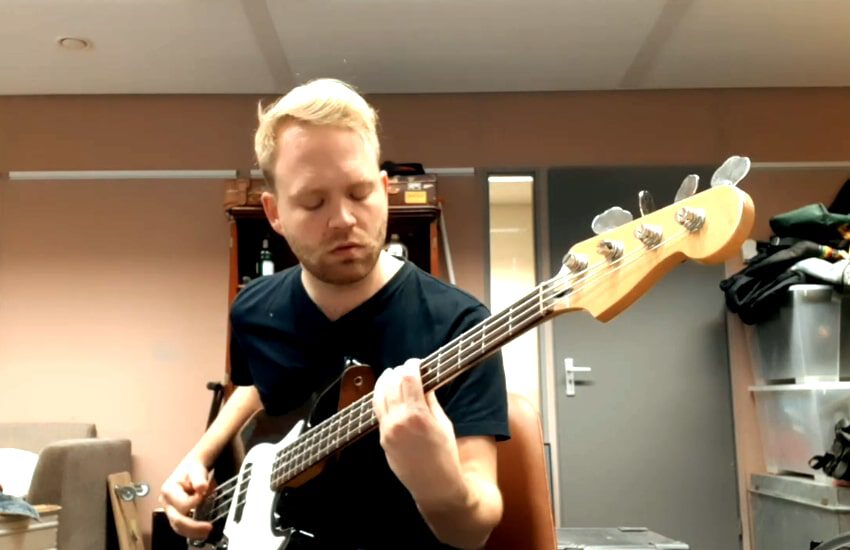This is the seventh video I recorded for my series about writing better basslines. Most bass players know some basic music theory. Applying the music theory to their playing however remains a mystery to a lot of them. With Groove Backpack I hope to solve some mysteries for bass player by giving examples of basslines and explaining the theory behind them. You can get the most out of these concepts by learning the basslines and experimenting with them for yourself. Try to grab something from the bassline you like and use it in different situations.
If you want to read more about my philosophy behind writing these basslines be sure to check out “How to write better basslines: The 4 ingredients“. Also take a look and listen to the other videos in this series via Groove Backpack.
The groove
The harmony
The composition I wrote consists of two sections. The first section features a bassline that is written around a D minor chord. On the 4th beat of every second bar I play an A7 (A dominant 7) chord. Notice how in the second bar I play the root of the A7 chord on the lasts two eight notes, and in the second variation (4th bar) I play the third (of the A7 chord) in the bass.
It’s perfectly fine to play another note than the root note when the chords change. As long as someone else in the band doesn’t clutter it up by playing in the bass register.
On the D minor chord I play the minor scale or Aeolian mode. The line has a lot of movement and is pretty busy. Because there is no melody/singing going on I can take up a lot of space without getting in the way of anything. When there is a melody I probably wouldn’t be able to take up so much space.
Always be aware of how much space in the audio spectrum/composition you are taking up.
Playing chords on bass using harmonics
In the B-section I did something that is a bit less conventional in bass playing. I added some harmonics to the piece. By playing a root note and letting it ring together with the harmonics, I created a chord. Although the harmonics I play are the same for the first three chords, the bassline descends chromatically. Adding tension and movement to the piece.
A beautiful example of using harmonics on bass is Portrait of Tracy by Jaco Pastorius. Check it out on YouTube,
In bars 9 till 12 I played the same figure but dropped every note a fifth down (I went from the A string to the E string). In the last bar I played the harmonic on the 7th fret, and then slid the harmonic down half a step. This changed the D into a C#, making the Asus an A major chord.
How do I know which note corresponds to which harmonic?
That is a good question! The harmonics I mostly use are the harmonics on the 4th fret, the 5th fret, the 7th, the 9th and the twelfth. There is also an harmonic just past the third fret, but I avoid it since it’s a lot harder make it sound good.
If you take a look at the table below you can see how the harmonics correspond to their place on the neck of the bass:
| Fret | Corresponding note |
|---|---|
| 4th | The same note as the fretted note but an octave higher. |
| 5th | The same note as the open string but an octave higher. |
| 7th | The same note as the fretted note but an octave higher. |
| 9th | A fifth and an octave above the fretted noted (same harmonic as on the 4th fret). |
| 12th | The same note as the fretted note. |
And if you look at the next table you’ll see which note is in each position per string. If you have a 5 or 6 string bass try to figure out the notes for the missing strings.
| Fret | G-string | D-string | A-string | E-string |
|---|---|---|---|---|
| 4th | B | F# | C# | G# |
| 5th | G | D | A | E |
| 7th | D | A | E | B |
| 9th | B | F# | C# | G# |
| 12th | G | D | A | E |
Making chords out of these harmonics
Combining notes together lets you create chords. Check out the transcription via the download link to figure out which chords are in this composition. Also try to find your own chords. If you want to learn more about how chords are constructed you should check out:
Download and more grooves
If you want to download the whole transcription as a pdf, you can click here.
Be sure to check out the rest of the free series via:
https://bassessentials.com/category/free-bass-lessons-online/how-to-write-basslines-groove-backpack/

Subscribe for new grooves
Do you enjoy Groove Backpack? You can subscribe using the form below to get notifications as soon as new grooves are available.
I hope you found this article helpful! Let me know in the comments what your thoughts are and if you have any questions or suggestions.

